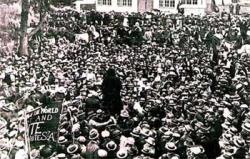
Published date
9 January 1922
In January 1922 some 22 000 white miners downed their tools and went on strike in what became known as the Rand Rebellion or the Red Revolt. Eventually martial law was proclaimed and the Smuts government sent in the defence force, which effectively crushed the general strike. By the end of the strike 153 miners had been killed and 500 wounded; 5000 strikers had been arrested of whom 4 were later hanged for treason. The breaking of the strike also resulted in the virtual destruction of the white trade unions' bargaining power. Hundreds of white miners were subsequently laid off and those who were not had to be satisfied with lower wages and the deskilling of certain jobs.
The strike occurred during a period of economic depression following World War I, when mining companies were faced with rising costs and a fall in the price of gold. Mining Capital realised the need to reduce costs and it did so by targeting what it deemed unduly highly paid white labour. The Chamber of Mines therefore announced that they would reduce labour costs by removing the colour bar and increasing the ratio of black workers to white, for although the wages for whites had risen 60 per cent since World War I, wages for blacks had increased only 9 per cent.
Related:
SAHO feature on the Rand Rebellion
References
The Star, 09th Jan 2004, 'Milestones'.|
miningweekly, 'The lead-up to the 1922 Rand Revolt',Available at: www.miningweekly.com,[Accessed on 09 December 2013]